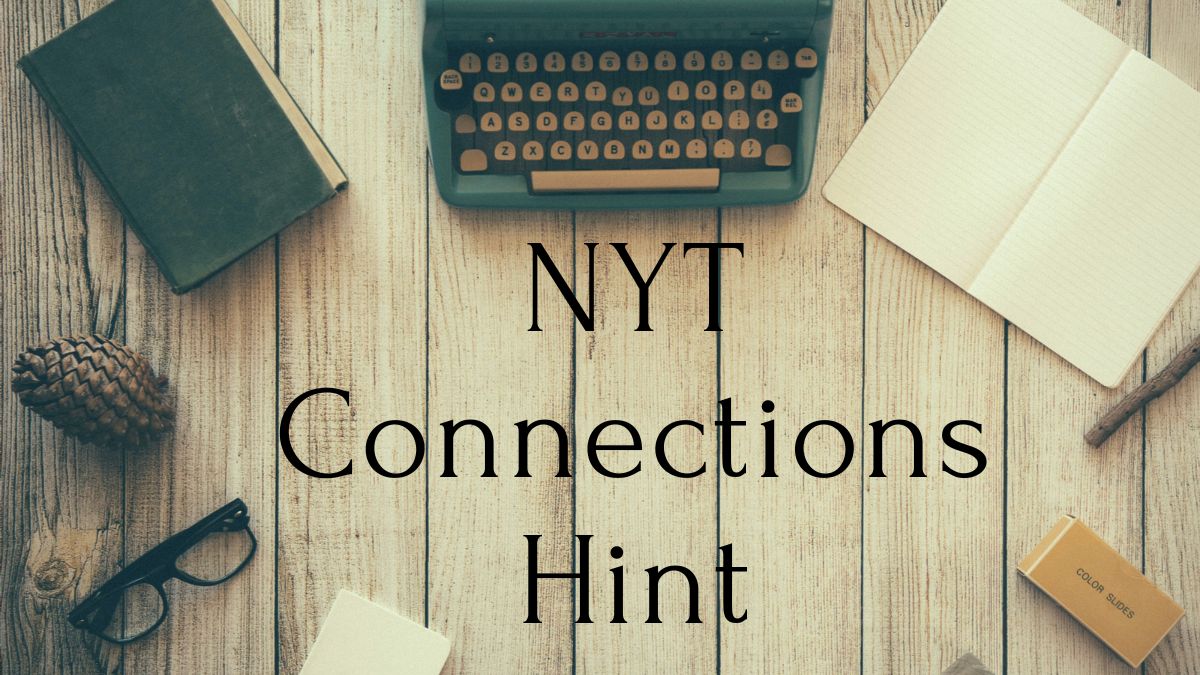EDUCATION
Uncovering the Hidden Gems: Exploring the Informative NYT Connections Hint Blog Article

Are you ready to dive into a world of mind-bending puzzles, NYT Connections Hint literary references, and trivia tidbits? Look no further than The New York Times’ beloved game – Connections! This addictive crossword puzzle variant challenges your knowledge, creativity, and ability to think outside the box. And in this blog post, we’re here to uncover all the hidden gems of Connections!
Whether you’re a seasoned player or new to this brain-teasing game, we’ve got you covered. From deciphering today’s themes and categories to revealing those elusive one-answer connections – there’s something for everyone. So grab a cup of coffee, sharpen your pencils (or flex those mental muscles), and let’s embark on an exciting journey through the world of NYT Connections Hint Connections!
But first things first – what exactly is Connections? Well, it’s like nothing else out there. In this delightful twist on traditional crosswords, each puzzle features two-word phrases that share a common word between them. Your task? To figure out that magical connection! It might be a synonym or even just a clever play on words NYT Connections Hint.
Now that you know what awaits you in this puzzling adventure called Connections let’s jump right into how to play it! Trust us; once you start playing, it’ll be hard to resist its captivating allure. Get ready for hours of entertainment as we unravel today’s hints and answers together.
So without further ado…let’s begin exploring these tantalizing clues and unlocking the secrets behind every connection waiting for us in today’s challenge!
How to Play Connections
Welcome to the exciting world of Connections, where your knowledge and quick thinking will be put to the test! Playing Connections is a fun and challenging way to expand your horizons and make connections between seemingly unrelated things. Here’s how it works:
First, you’ll be presented with a series of clues or categories. Your job is to find the word that connects them all together. It could be a common theme, an obscure fact, or even a play on words. The key is to think outside the box and let your creativity flow.
Once you’ve figured out the connection, type in your answer and see if you’re correct! Don’t worry if you get stumped at first – sometimes the answers are hidden in plain sight. Keep practicing, honing your skills, and soon you’ll become a master of making connections.
So what are you waiting for? Grab a pen and paper (or pull up our digital version) and dive into this mind-bending puzzle game today! Challenge yourself with new themes every day or revisit old ones for a fresh perspective. Happy connecting!
Today’s Connections Hints and Answers
If you’re a fan of the New York Times crossword puzzle, then you’ve probably heard about Connections. It’s an addictive game that challenges your ability to find commonalities between seemingly unrelated words or phrases. And guess what? Today, we’re diving into the hints and answers for this mind-boggling game!
In today’s edition of Connections, prepare yourself for some intriguing themes and categories. From famous quotes to classic movies, you’ll be amazed at how these connections can bring together seemingly disparate ideas in one cohesive puzzle.
But wait! There’s more! We won’t leave you hanging without revealing one-answer connections. That’s right – we’ll give you a glimpse into the hidden gems within each puzzle, unveiling those elusive links that might have stumped even the most seasoned players.
So where can you find today’s Connections puzzles? Look no further than the New York Times website or mobile app. With just a few taps or clicks, you’ll have access to hours of brain-teasing fun at your fingertips.
Ready to improve your prowess in this captivating game? Here are some tips and tricks to help you navigate through those challenging clues like a pro:
1. Start with easy connections: Build confidence by tackling straightforward word associations first.
2. Think outside the box: Don’t limit yourself to literal meanings; explore figurative interpretations as well.
3. Use context clues: Read surrounding clues carefully as they often provide valuable hints for solving tricky connections.
And remember – practice makes perfect! The more puzzles you solve, the better equipped you become at unraveling these tantalizing word links.
Looking for a deeper understanding of today’s difficulty level? Need an extra hint to crack that tough connection? Check out The Connection Companion – an insightful blog dedicated solely to helping puzzlers like yourself conquer every challenge thrown their way.
To enhance your gameplay experience further, take advantage of additional reading materials and resources available to you. From crossword dictionaries to online forums, the puzzle-solving
Today’s Themes and Categories
Every day, NYT Connections Hint Connections puzzle offers a unique set of themes and categories to challenge your mind. These carefully curated topics span a wide range of subjects, from literature and history to pop culture and science. With each new edition, you can expect a fresh mix of clues that will test your knowledge in unexpected ways.
One thing that makes Connections so exciting is its ability to combine seemingly unrelated ideas into cohesive groups. You might find yourself linking famous authors with their beloved characters or connecting musical genres with iconic album covers. The possibilities are endless, making each solve an adventure in creative thinking.
So whether you’re a trivia junkie or just looking for a fun way to exercise your brain, today’s themes and categories in Connections are sure to keep you entertained. Get ready for an intellectual journey through diverse disciplines as you uncover hidden connections between the most unlikely pairings. How many links can you discover?
Reveal of One-Answer Connections
The moment we’ve all been waiting for has arrived! It’s time to reveal the one-answer connections in today’s game. Get ready to have your mind blown as we uncover the hidden gems that tie these seemingly unrelated clues together.
In this round of Connections, prepare to be amazed by the ingenious ways in which words and concepts can be linked. From famous historical figures to obscure scientific theories, you never know what kind of connection awaits you. So sharpen your wits and get ready for a mental journey like no other!
As each answer is unveiled, you’ll find yourself marveling at the cleverness behind it. How did they come up with such an unexpected association? The beauty of Connections lies not only in its ability to challenge our knowledge but also in its capacity to surprise us with new insights into the world around us.
So keep those gears turning and soak up every revelation. As you explore today’s one-answer connections, let your curiosity guide you towards discovering more hidden treasures within this intriguing puzzle game. Who knows what fascinating tidbits await your discovery?
Remember, there are always more connections out there just waiting to be unraveled – so stay curious and keep playing!
Where to Find Connections
Have you been bitten by the Connections bug and now you can’t get enough? Well, fear not, because I’m here to share some insider tips on where to find these brain-teasing puzzles! Whether you’re a newspaper aficionado or prefer the convenience of digital platforms, there are plenty of places to indulge in your Connections addiction.
First up, let’s talk about The New York Times itself. If you’re a subscriber, you’ll have access to their renowned Crossword app and website. And guess what? Connections is just a click away! You can dive into the daily puzzle right alongside all the other engaging content curated by NYT Connections Hint Connections Hint.
But if physical newspapers are more your thing, don’t worry—they haven’t forgotten about you either! Simply flip through the pages of The New York Times print edition and keep an eye out for that beloved Connections section. It’s like finding buried treasure!
And finally, for those who love digital convenience but crave variety beyond NYT Connections Hint Connections Hint—there are several online platforms that offer connections-style puzzles. From dedicated puzzle websites to mobile apps galore—you’ll never run out of fresh challenges to test your mental acuity.
So go ahead and explore these hidden gems where Connections awaits—it’s time to feed your puzzling addiction!
Tips and Tricks for Connections
1. Start with the Clues:
When tackling a Connections puzzle, it’s important to carefully read through all the clues before making any connections. Look for keywords or phrases that could link different answers together.
2. Think Outside the Box:
Don’t be afraid to think creatively when making connections. Sometimes, a seemingly unrelated answer can have a hidden connection to another clue. Keep an open mind and explore different avenues of thought.
3. Use Process of Elimination:
If you’re stuck on a particular connection, try eliminating answers that don’t fit with the given clue or theme. This can help narrow down your options and make it easier to find the correct connections.
Remember, practice makes perfect! The more you play Connections, the better you’ll become at spotting those elusive links between answers. So keep challenging yourself and have fun uncovering hidden gems in each puzzle!
Stay tuned for our next blog post where we reveal even more strategies to master NYT Connections Hint Connections!
The Connections Companion:A Must-Read
If you’re a fan of the New York Times’ Connections puzzle, then The Connections Companion is an absolute must-read. This comprehensive guide provides valuable insights and strategies to help you navigate through the intricate web of connections with ease!
In this treasure trove of knowledge, you’ll find expert tips and tricks for deciphering even the most challenging connections. From understanding today’s difficulty levels to uncovering hidden patterns, this companion will unlock the secrets behind each puzzle.
But that’s not all – The Connections Companion also offers in-depth analysis of previous puzzles, allowing you to learn from past themes and categories. With this wealth of information at your fingertips, you’ll be able to approach each new connection with confidence and precision.
So whether you’re a seasoned Connections enthusiast or just starting out on your journey, The Connections Companion is your ultimate companion for unraveling the mysteries within every puzzle. Get ready to dive into a world where words intertwine in fascinating ways – it’s time to take your connections skills to new heights!
Understanding Today’s Difficulty
When it comes to playing Connections, understanding the level of difficulty for each puzzle is crucial. Each day brings a new challenge, with varying themes and categories to test your knowledge. The level of difficulty can range from easy to mind-bogglingly difficult, keeping you on your toes and pushing your brainpower to its limits.
The puzzles are carefully curated by the New York Times team to provide a diverse range of topics that cater to different interests. Some days may feature pop culture references or current events, while others may delve into history or science. This variety ensures that every player has something they can connect with (pun intended) and keeps the game fresh and exciting.
To navigate through today’s difficulty level, it’s essential to approach each connection with an open mind. Don’t be discouraged if you find yourself stumped at first glance – take a step back, analyze the clues provided, and think outside the box. Remember that connections aren’t always straightforward; sometimes they require lateral thinking or making unexpected associations.
So don’t fret if today’s puzzle seems particularly challenging – embrace it as an opportunity for growth and expanding your knowledge. With practice and persistence, you’ll become more adept at deciphering those hidden gems within Connections!
Need a Hint? Check this Out.
Sometimes, even the most seasoned puzzlers need a little help. That’s where hints come in handy. Whether you’re stuck on a particular clue or just want to give your brain a nudge in the right direction, Connections provides hints to keep you moving forward.
The great thing about Connections is that there are multiple ways to get hints. First and foremost, you can find them directly within the game itself. Just click on the “Hint” button and you’ll be presented with some useful clues that will point you towards solving those tricky connections.
If you prefer more interactive assistance, head over to the NYT Connections Hint Crossword Twitter account (@NYTimesWordplay). Every day, they tweet out additional hints for that day’s puzzle. It’s a great way to get some extra guidance while also staying connected with other crossword enthusiasts.
So don’t be afraid to seek out hints when needed – they’re there to enhance your puzzle-solving experience and help unlock those hidden gems of knowledge! Happy connecting!
Further Reading and Additional Resources
When it comes to Connections, there’s always more to explore. If you’re hungry for additional challenges and want to dive deeper into the world of wordplay, there are plenty of resources available to satisfy your curiosity.
1. Books:
Expand your knowledge with books that delve into the art of making connections. From puzzle collections that will keep you entertained for hours to guides that offer tips and tricks on how to improve your skills, these books are a treasure trove of information.
2. Online forums:
Connect with fellow enthusiasts on online forums dedicated to Connections. Share your strategies, exchange ideas, and discuss today’s hints and answers in a vibrant community of like-minded individuals who share your passion for this addictive game.
3. Websites:
Keep an eye out for websites that provide regular updates on Connections puzzles from The New York Times. These sites often feature analyses, breakdowns of themes, and discussions about the clues—perfect for those who enjoy dissecting the intricacies behind each connection.
So don’t stop at just solving Connections; immerse yourself in a world where words come together in unexpected ways! Explore these further reading materials and additional resources for endless opportunities to sharpen your skills and discover even more hidden gems within this captivating game.
Conclusion
H2: In this blog post, we have delved into the world of Connections, a fascinating and informative game offered by The New York Times. We have explored how to play, where to find it, and even shared some tips and tricks for success.
Connections is a fantastic way to engage your mind and expand your knowledge across various themes and categories. It challenges you to make connections between seemingly unrelated words or phrases, testing your ability to think critically and creatively.
Whether you’re new to Connections or a seasoned player looking for an extra challenge, the daily hints are invaluable in helping you uncover those hidden gems. They provide just enough guidance without giving away the answers completely.
For those who truly want to enhance their experience with Connections, The Connections Companion is a must-read companion piece. It offers insights into the difficulty levels of each puzzle as well as additional resources for further exploration.
So why not take on today’s Connections challenge? Sharpen your thinking skills while having fun along the way! And remember, when you need that little nudge in the right direction, check out the helpful hints available on The New York Times website.
EDUCATION
Expanding Horizons: Supporting Educational Outreach

Educational outreach initiatives play a vital role in broadening access to quality education, fostering community engagement, and nurturing a culture of lifelong learning. In this blog post, we’ll delve into the realm of educational outreach, exploring the significance of supporting learning initiatives and the transformative impact of expanding horizons through educational outreach programs.
Empowering Underserved Communities
Educational outreach programs aim to empower underserved communities by providing access to educational resources, mentorship, and skill-building opportunities. These initiatives bridge the gap in educational equity, enabling individuals from diverse backgrounds to pursue learning and personal development.
Collaborative Partnerships and Stakeholder Engagement
Successful educational outreach often hinges on collaborative partnerships with stakeholders such as schools, nonprofits, government agencies, and corporate sponsors. By leveraging diverse expertise and resources, these partnerships amplify the impact of educational outreach, reaching a broader audience and addressing multifaceted educational needs.
Enriching Learning Experiences
Educational outreach enriches learning experiences by introducing innovative teaching methods, extracurricular activities, and hands-on learning opportunities. These initiatives ignite curiosity, creativity, and critical thinking, fostering a holistic approach to education that extends beyond traditional classroom settings.
Mentorship and Role Modeling
Mentorship programs embedded within educational outreach initiatives provide guidance, support, and positive role modeling for participants. Mentors serve as invaluable sources of inspiration, offering insights, encouragement, and practical advice to help individuals navigate their educational and career pathways.
Digital Literacy and Access to Technology
In an increasingly digital world, educational outreach efforts prioritize promoting digital literacy and ensuring access to technology resources. By equipping learners with essential digital skills and tools, these programs prepare individuals to thrive in an interconnected, technology-driven society.
Career Exploration and Readiness
Educational outreach programs often incorporate career exploration activities and readiness workshops, exposing participants to diverse career paths and helping them develop the skills and mindset necessary for future professional success. Such initiatives instill confidence and ambition in pursuing meaningful careers.
Community Building and Social Impact
Educational outreach fosters community building and social impact by nurturing a sense of belonging, civic responsibility, and collective investment in education. These programs cultivate a supportive network that celebrates learning, fosters collaboration, and uplifts the entire community.
Bridging the Gap through B2G Marketing Strategies
In educational outreach, using B2G (Business to Government) marketing boosts visibility and effectiveness. Targeting governmental agencies secures funding, endorsements, and partnerships, amplifying program impact. Effective B2G strategies highlight educational benefits like social value, community enhancement, and lifelong learning promotion among underserved groups. This approach garners support and resources for lasting impact on educational programs.
Lifelong Learning Advocacy
Through educational outreach, advocacy for lifelong learning is championed, emphasizing the value of continual personal and professional development across all stages of life. By promoting a culture of lifelong learning, these initiatives instill a growth mindset and adaptability in individuals, encouraging ongoing self-improvement.
Cultural Exchange and Global Awareness
Many educational outreach programs embrace cultural exchange and global awareness, broadening participants’ perspectives and fostering cross-cultural understanding. Exposure to diverse cultures, languages, and traditions nurtures empathy, respect, and a deeper appreciation for global interconnectedness.
Partnerships with Educational Institutions
Collaborating with educational institutions, including K-12 schools and universities, enhances the reach and impact of educational outreach initiatives. Establishing partnerships with academic institutions enables the integration of educational outreach programs into formal curricula and student support services, amplifying their influence.
Conclusion
Educational outreach is a catalyst for expanding horizons, empowering individuals, and driving positive change through accessible, impactful learning initiatives. By supporting educational outreach efforts, communities can uplift and transform lives, creating a legacy of educational empowerment and lifelong learning. Embrace these strategies to champion educational outreach and contribute to a world where learning knows no bounds.
EDUCATION
Convocatoria para Auxiliares de Educación 2024

Educators from all over the globe are being sought after through the Convocatoria para Auxiliares de Educación 2024, often known as the Call for Education Assistants. Learn about the function of the educational auxiliary, how to apply, and the advantages, disadvantages, and possibilities that come with it in this in-depth essay.
What Does It Mean to Be an Auxiliary in Education?
When it comes to helping out instructors and educators in different classrooms, auxiliary aids are indispensable. Among their many roles is the facilitation of extracurricular activities, language immersion programs, and classroom support. Their primary function is to supplement students’ educational experience by providing them with useful materials.
Benefits of Being an Auxiliary in Education
Professional Development Opportunities
Among the many advantages of taking part in the Convocatoria para Auxiliares de Educación is the chance to advance in one’s career. Auxiliaries improve their leadership, organizational, communication, and hands-on experience in a classroom setting.
Contribution to Education
Becoming an auxiliary is a great way for folks to help enhance education all throughout the world. In the end, they help students have a more inclusive and enjoyable educational experience by bridging gaps in language acquisition, cultural understanding, and academic assistance.
Networking and Collaboration
There is an opportunity for auxiliaries to meet and work with administrators, teachers, and other auxiliaries from all walks of life. Through working together, they are able to expand their professional networks and experience other cultures.
Requirements and Qualifications
There are specific conditions and qualities that candidates must achieve in order to participate in the Convocatoria para Auxiliares de Educación 2024.
Educational Background
Applicants are often required to hold a Bachelor of Science degree in teaching, languages, or a closely connected field. Some programs may also provide preference to applicants with relevant work experience.
Skills and Competencies
The ideal candidate will be able to communicate clearly, understand and respect different cultures, and work well with people from different backgrounds. Depending on the position, you may need to be fluent in more than one language in addition to the language of teaching.
Language Proficiency
Given the nature of the position, fluency in the teaching language is absolutely necessary. Candidates may be asked to present standardized test results or language certificates as evidence of their language competency.
How to Apply for Convocatoria para Auxiliares de Educación 2024
Application Process
The application procedure usually entails uploading a résumé, cover letter, academic credentials, and an online application form. A personal statement and/or recommendation letters may be necessary for admission to some programs.
Necessary Documents
The program usually requests that candidates provide copies of relevant certifications or papers, such as certificates of language competency or educational qualifications, among others.
Deadlines
Please be sure you submit your applications by the dates and times given by the program administrators. Please ensure that all required papers are submitted on time; applications received after the deadline will not be considered.
Tips for a Successful Application
Tailoring Your Resume
To show that you are qualified for the position of educational auxiliary, tailor your resume to emphasize your relevant experiences, abilities, and credentials. Highlight your language skills, past tutoring or teaching experience, and cross-cultural understanding.
Highlighting Relevant Experience
Whether it’s working with kids, teaching languages, or being involved in educational projects, highlight any relevant experience you have. You can bolster your application by showcasing concrete instances of your contributions to educational environments.
Demonstrating Passion for Education
Tell kids how much you care about their education and how you intend to make a difference in their lives. Please elaborate on your interest in becoming an educational auxiliary and the benefits you and the students you will be working with stand to reap from this role.
Selection Process
Several steps, such as screening, interviews, and evaluation, are usually included in the selection process for the Convocatoria para Auxiliares de Educación.
Screening
As part of the screening process, applicants are examined to make sure they fulfill the program’s minimal criteria and credentials. Those that are qualified can move on to the next round of interviews.
Interviews
The next step is to invite the candidates who made the cut to an interview, which might take place in person or over video chat. Candidates get a chance to demonstrate their qualifications for the position and highlight relevant experiences during the interviews.
Assessment
Language proficiency exams, teaching demos, and situational judgment tests are some of the extra evaluations that candidates may have to complete. In order to determine if an applicant is qualified to serve as an educational auxiliary, program organizers use these tests.
Training and Orientation
Successful participants in the Convocatoria para Auxiliares de Educación get comprehensive training and orientation prior to beginning their new positions.
Preparation for the Role
Auxiliaries learn all they need to know about their jobs, duties, and expectations in the lead-up to the Role Training workshops. Cultural awareness, classroom management, and lesson preparation are some areas that they could want some help with.
Understanding Policies and Procedures
Codes of conduct, emergency procedures, and safety requirements are some of the regulations that auxiliary workers learn about. By familiarizing themselves with these guidelines, they may ensure a smooth transfer into their duties.
Placement and Assignment
Auxiliaries are placed at educational institutions all around the world once they finish training and orientation.
Location Preferences
During the application process, a candidate may be asked to select a placement site. Program criteria and availability, with preferences taken into consideration, decide final placements.
Role Assignments
Classroom assistants, language tutors, and cultural ambassadors are just a few examples of the auxiliary jobs that could be offered to them by the school. To thrive in these positions, you need to be able to pivot and change with the times.
Expectations
Professionalism in dealings with children, teachers, and the community, as well as a strict adherence to program standards and procedures, are all expectations of auxiliary workers.
Support and Resources
Education auxiliary workers are provided with continuous assistance and resources to enable them to excel in their positions.
Mentorship Programs
Through mentorship programs, some organizations provide new recruits with the chance to learn from more seasoned auxiliary members. Mentors guide new auxiliary through difficult times by providing guidance, sharing best practices, and offering counsel.
Access to Educational Materials
Educational materials, tools, and curriculum guidelines may be available to auxiliary workers so that they may better design and deliver courses. In order to accomplish their pedagogical goals, auxiliaries rely on these materials to supplement student learning.
Assistance Channels
Typically, program organizers would set up channels where auxiliaries may go to get advise or aid with things like administrative tasks, cultural adaptations, or even just their personal lives. Auxiliaries will feel supported during their assignments thanks to these outlets.
Career Growth and Advancement Opportunities
Opportunities for professional development and promotion abound for those who take part in the Convocatoria para Auxiliares de Educación.
Continuing Education
During or after their assignments, auxiliary workers may be able to take advantage of chances for continuing their studies or advancing their careers. Some examples of such programs are language classes, credentials to teach, or advanced degrees in subjects connected to education.
Promotional Pathways
Auxiliaries that demonstrate exceptional performance may be eligible for promotions that lead to leadership positions or career advancement opportunities within the company. Possibilities for mentoring, program coordination, or project management may arise in this context.
Challenges Faced by Auxiliaries in Education
Auxiliaries in education have many opportunities for growth and development, but they also face unique obstacles in their field postings.
Language Barriers
When deployed in settings where they do not speak the native language fluently, auxiliaries may find it particularly difficult to overcome linguistic obstacles. One way to overcome this difficulty is by utilizing language immersion techniques and effective communication skills.
Cultural Adaptation
Particularly for auxiliary stationed in foreign nations with diverse cultural practices, it can be difficult to adapt to a new social and cultural milieu. Adapting to a new culture might be easier with cultural sensitivity training and chances for cultural interchange.
Work-Life Balance
It could be difficult to juggle the responsibilities of the auxiliary position with other priorities, such as personal obligations and free time. To strike a good work-life balance, auxiliary workers may need to learn to control their emotions and set limits for themselves.
Success Stories
Testimonials from Previous Auxiliaries
Auxiliaries who have participated in programs like the Convocatoria para Auxiliares de Educación often speak highly of the program and its impact on their lives. These anecdotes show how the training helped people develop both personally and professionally.
Impact on Personal and Professional Growth
The Convocatoria para Auxiliares de Educación is a great opportunity for auxiliaries to develop both personally and professionally. In the process, they grow as people and acquire knowledge that will be useful in all their future pursuits.
Community Engagement and Integration
Participation in cultural exchange events and networking with local community members are highly encouraged for auxiliaries.
Involvement in Local Communities
Volunteering, attending cultural events, and participating in community activities are all great ways for auxiliary to become connected in the local culture and meet interesting people.
Cultural Exchange
Auxiliaries can promote cross-cultural understanding and appreciation by sharing aspects of their own culture with the populations they assist.
Building Relationships
Strong relationships formed with members of the community, instructors, and students lead to a more interesting classroom and more rewarding extracurricular activities.
Conclusion
The Convocatoria para Auxiliares de Educación 2024 is a great chance for anyone who want to make a difference in education all around the globe. Anyone may make a difference in the lives of kids all across the globe, get practical experience, and earn important skills by being an auxiliary.
FAQs:
What is the duration of the Convocatoria para Auxiliares de Educación placements?
A placement’s usual length might vary from a few months to an entire academic year, depending on program and placement-specific criteria.
Can I participate in the program if I don’t have prior teaching experience?
Though it’s usually helpful, having teaching experience isn’t necessary. Individuals that are enthusiastic about education and eager to learn are often welcomed by various programs.
Are there age restrictions for participating in the Convocatoria para Auxiliares de Educación?
Age restrictions are program-specific. Applicants of any age may be considered for some programs, while others have stricter age requirements.
Is financial assistance provided for travel and accommodation expenses?
Some schools provide financial aid in the form of stipends or grants that might help defray the cost of travel and lodging. However, this is decided by the course of study and the location of the placement.
What support is available for auxiliaries facing challenges during their placements?
Mentorship programs, psychological services, and administrative help are just a few of the ways in which program organizers make themselves available to auxiliary workers.
EDUCATION
Direct Educational Services: Revolutionizing Learning

You have entered the revolutionary world of direct educational services, where knowledge has no bounds. To help you better comprehend the topic, we explore the relevance, difficulties, and developments of direct educational services in this article.
What are Direct Educational Services?
Individualized lesson plans are an integral part of direct educational services. Personalized techniques are the main emphasis of these services, which provide an atmosphere that is both dynamic and interesting for learning, as opposed to the more conventional approach.
Importance of Direct Educational Services:
The future of education is heavily influenced by direct educational services, which are of utmost importance. Students are more invested, which in turn improves their academic performance and fosters a lifelong passion for learning when lessons are personalized to their individual needs.
How Direct Educational Services Benefit Learners:
The advantages are numerous, ranging from catering to different learning styles to offering specific assistance. Students are given the one-on-one attention they need, which helps them feel empowered and confident as they go through their education.
Types of Direct Educational Services:
Explore many forms of direct educational services, such as individualized education programs, workshop formats, and tutoring services. An all-encompassing and flexible learning environment is guaranteed by the fact that each kind is designed to meet individual needs.
Personalized Learning Programs:
Investigate how well students do in individualized learning programs that allow them to move through the curriculum at their own speed. By laying a firm groundwork for future learning, this approach improves understanding and memorization.
Challenges in Direct Educational Services:
Despite the many advantages, there are still obstacles in the way of direct educational services. In order to successfully deploy direct educational service’s, it is essential to overcome obstacles including limited resources and reluctance to change.
Overcoming Barriers in Implementation:
Tackling obstacles calls for careful preparation and teamwork. Find effective ways to deal with opposition and work around limited resources so that direct educational service’s may be integrated smoothly.
Direct Educational Service’s in the Digital Age:
Make the most of the information technology revolution by providing direct educational service’s online. Find out how DSEs are improving students’ access to and engagement with education by utilizing technology to provide more interesting and relevant learning experiences.
Leveraging Technology for Better Education:
Investigate how technology, such as dynamic web-based platforms and comprehensive virtual experiences, might be used to enhance the educational process. Learn how these innovations prepare students for a tech-driven future and improve learning outcomes.
Key Players in Direct Educational Services:
Recognize the pioneers in the field of direct educational services; they are key players. These influential organizations, ranging from young, tech-savvy startups to long-standing, well-respected universities, are changing the face of direct educational services and the world as we know it.
Success Stories in Direct Educational Service’s:
See the difference via motivational success stories in direct education service’s. Feel the power of direct educational services as you observe the lives of kids being changed for the better.
Real-life Transformations:
Case studies demonstrating effective implementations provide insight into real-world transformations. Find out what worked by dissecting these success stories and applying what you learn to your own endeavors.
Case Studies:
Through the use of case studies, we can better understand the impact that direct educational service’s have had in the past. These examples show how individualized learning may boost students’ academic performance and engagement.
Analyzing Successful Implementations:
Discover the commonalities among successful situations by analyzing successful implementations. Gain an understanding of the critical success elements, which will serve as a guide for schools and teachers seeking to successfully adopt direct educational service’s.
Innovations in Direct Educational Service’s:
Take a look ahead at what’s to come. Learn about the latest innovations influencing the future of direct educational service’s, such as gamified education and AI-driven learning systems.
Future Trends and Developments:
Look forward to how direct educational services will change in the future. Discover how the educational environment will be even more inclusive and successful as a result of future trends and advances that improve the learning experience.
Direct Educational Service’s and Student Success:
Determining the relationship between direct educational assistance and student achievement is an important goal. Investigate research that has quantified the effect on student performance in the classroom to back up claims that individualized instruction works.
Measuring the Impact on Academic Achievement:
Investigate studies and research that demonstrate how direct educational service’s improve academic results. Gain an appreciation for the ways in which individualized instruction helps students succeed and gets them ready for what’s to come.
Addressing Concerns about Direct Educational Service’s:
In order to achieve broad acceptability, it is essential to address concerns regarding direct educational service’s and dispel myths and misunderstandings. Get to the bottom of people’s frequent questions and concerns about direct educational service’s by answering their questions and providing explanations.
Common Misconceptions and Clarifications:
Clear the air by addressing common misunderstandings, such as those on cost and efficacy. Make direct educational service’s more accessible and effective by providing explanations backed by evidence.
Best Practices for Implementing Direct Educational Service’s:
Follow recommended practices to successfully complete the installation process. From outlining specific objectives to performing continuous evaluation, these suggestions cover all the bases and ensure the effective and lasting integration of direct educational service’s.
Ensuring Effectiveness and Sustainability:
Thorough explanations of what works ensure a successful rollout. In order to make sure that direct educational service’s are successful and sustainable in the long run, educators and institutions should follow these strategies.
The Future of Direct Educational Service’s:
Conclude with some thoughts on how direct educational service’s will continue to adapt to new circumstances. Think about where you are now and where you want to go, drawing attention to your dedication to constant growth and innovation.
Evolution and Continuous Improvement:
As we wrap up, let us welcome the ever-changing landscape of direct educational service’s. With a dedication to offering students all across the globe exceptional educational opportunities, the future is filled with thrilling prospects.
Conclusion:
Finally, when it comes to innovation and individualized instruction, direct educational service’s shine brightest. This comprehensive guide has shown the significance, challenges, success stories, and future trends of direct educational services, further demonstrating their transformative impact.
FAQs:
Q: Are direct educational service’s suitable for all age groups?
Sure thing! Students of various ages, from those in elementary school to working people looking for continuing education, can benefit from direct educational services.
Q: How do personalized learning programs benefit students?
Personalized learning programs can enhance students. Comprehension and enthusiasm by adjusting their learning style and pace to suit their specific needs.
Q: What role does technology play in direct educational service’s?
By facilitating more accessible and engaging learning through the provision of interactive platforms. Virtual experiences, and tools driven by artificial intelligence, technology improves direct educational services.
Q: How can institutions overcome resistance to implementing direct educational service’s?
The best way to overcome opposition and create an atmosphere conducive to implementation is to communicate openly, highlight success stories, and include stakeholders in the decision-making process.
Q: Are there any notable success stories of students benefiting from direct educational service’s?
Sure thing! The article is filled with motivational success stories that show how direct educational service’s have improved students’ lives.
Q: What are the key factors for ensuring the sustainability of direct educational services?
The success and sustainability of direct educational service’s over the long term depend on having clear objectives, regularly assessing progress, and adjusting to changing educational environments.
-

 HEALTH1 month ago
HEALTH1 month agoSmile Wide: The New Dentist’s Guide to Launching a Successful Career
-

 TECHNOLOGY1 month ago
TECHNOLOGY1 month ago몽세리 266b+v: Unraveling the Mystery Behind It
-

 GENERAL1 month ago
GENERAL1 month agoTop Fertilizer Suppliers Malaysia: Boosting Agriculture with Quality Nutrients
-

 GENERAL2 months ago
GENERAL2 months agoHelping Hands:The Role of Employee Assistance Programs
-

 NEWS1 month ago
NEWS1 month agoLakewood News Network: Keeping You Connected Locally
-

 BUSINESS2 months ago
BUSINESS2 months agoFine-Tuning Success: Tips for Optimizing Your Advertising Agency
-

 GENERAL2 months ago
GENERAL2 months agoThe Unspoken Reality: Breaking the Silence on Unwanted Pregnancy
-

 BUSINESS1 month ago
BUSINESS1 month ago10 Business AI Tools by abc-media.net: Revolutionizing Your Workflow

